Kirby Larson's Blog, page 21
February 7, 2014
Friend Friday
Tim Capehart holds 1/15th of a very special spot in my heart: he was a member of the 2006 Newbery Committee that bestowed Hattie Big Sky with a Newbery Honor. [sigh] But underneath those glasses and that mild-mannered librarian expression, there lurks a novelist. I am delighted to turn this space over to Tim so he can tell us about his brand-new debut novel!
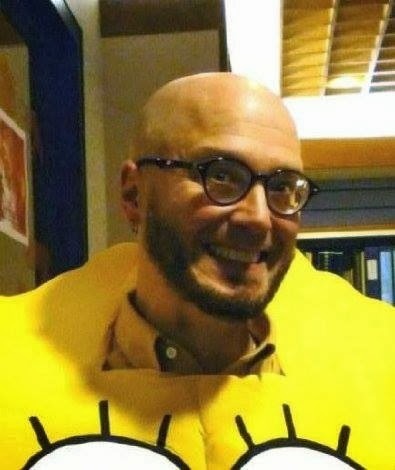 Tim Capehart
Tim Capehart
I wished whole-heartedly when I was small (Mom will tell you I have never been young…while my husband Trent will tell you I haven’t grown up yet) that someone would pay me to read. I realized a few years ago as I was approaching 700 books reviewed for Kirkus Reviews, School Library Journal, VOYA, Hornbook, Publishers Weekly (can you believe there’s an Etc. here?) that my childhood wish had come true.
Between reviewing and my daytime gig as a Children’s Librarian who has to read ‘em before I can buy ‘em, I was actually getting paid to read. I also wished as small-Tim that I could get paid to write. Because that fabulous feeling of a world coming to life even if that world is only a sentence nicely wrought, that feeling, a physical sensation of expansion at the back of my head, was and is the best feeling ever. Writing reviews even when blurbed on book covers or quoted back to me by managing editors of publishing houses just did not satisfy.
I had written short stories (with an undergraduate degree in Creative Writing, that’s not surprising) and seen some published. I had also written a couple novels no one wanted to put into print. So I put on my editor’s hat and published the stories myself. I polished off the novels and thought, “These are as good as some of what I review.” I set to work on one that started with a walk down a blustery Dorchester, Massachusetts street years ago when something dark and fluttery that wasn’t a bird or a bat up under the eaves of a triple-decker caught my eye and my imagination. When I considered it done, it met agents and editors who did not share my opinion of its doneness…or its good-enoughness. I wanted that traditionally published book (Even when reading, I don’t do eBooks, you’ll have to pry the paperback from my cold, dead hands…) I wanted to be published the normal way.
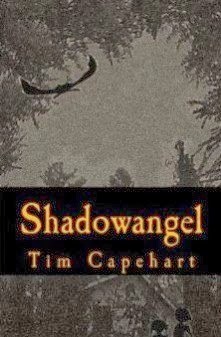
In Shadowangel, sixth-grader Josh is dragged from Dayton (my hometown, too) to Rock Hollow in the hills of south-central Ohio by his newly-divorced mother. He’s visited there many times; it’s his mother’s hometown. Rock Hollow is boring and full of odd characters not the least of which is his Granma who, as the retired town librarian, is full of tales of strange happenings and quirky family members. Josh just wants everything to get back to normal…to be normal. His new friend Marylis can’t wrap her head around that. She can’t imagine wanting to be normal; she, in fact, doesn’t even believe in normal. As she says, “Everyone since cavemen and until the sun dies is, was and will be weird.” So I decided not to spin my wheels for another year waiting for normal, and Shadowangelsaw print and met the world in December. The other two from the trunk may follow, and then we’ll see what happens next. It will definitely be normally weird.
 Tim Capehart
Tim CapehartI wished whole-heartedly when I was small (Mom will tell you I have never been young…while my husband Trent will tell you I haven’t grown up yet) that someone would pay me to read. I realized a few years ago as I was approaching 700 books reviewed for Kirkus Reviews, School Library Journal, VOYA, Hornbook, Publishers Weekly (can you believe there’s an Etc. here?) that my childhood wish had come true.
Between reviewing and my daytime gig as a Children’s Librarian who has to read ‘em before I can buy ‘em, I was actually getting paid to read. I also wished as small-Tim that I could get paid to write. Because that fabulous feeling of a world coming to life even if that world is only a sentence nicely wrought, that feeling, a physical sensation of expansion at the back of my head, was and is the best feeling ever. Writing reviews even when blurbed on book covers or quoted back to me by managing editors of publishing houses just did not satisfy.
I had written short stories (with an undergraduate degree in Creative Writing, that’s not surprising) and seen some published. I had also written a couple novels no one wanted to put into print. So I put on my editor’s hat and published the stories myself. I polished off the novels and thought, “These are as good as some of what I review.” I set to work on one that started with a walk down a blustery Dorchester, Massachusetts street years ago when something dark and fluttery that wasn’t a bird or a bat up under the eaves of a triple-decker caught my eye and my imagination. When I considered it done, it met agents and editors who did not share my opinion of its doneness…or its good-enoughness. I wanted that traditionally published book (Even when reading, I don’t do eBooks, you’ll have to pry the paperback from my cold, dead hands…) I wanted to be published the normal way.

In Shadowangel, sixth-grader Josh is dragged from Dayton (my hometown, too) to Rock Hollow in the hills of south-central Ohio by his newly-divorced mother. He’s visited there many times; it’s his mother’s hometown. Rock Hollow is boring and full of odd characters not the least of which is his Granma who, as the retired town librarian, is full of tales of strange happenings and quirky family members. Josh just wants everything to get back to normal…to be normal. His new friend Marylis can’t wrap her head around that. She can’t imagine wanting to be normal; she, in fact, doesn’t even believe in normal. As she says, “Everyone since cavemen and until the sun dies is, was and will be weird.” So I decided not to spin my wheels for another year waiting for normal, and Shadowangelsaw print and met the world in December. The other two from the trunk may follow, and then we’ll see what happens next. It will definitely be normally weird.
Published on February 07, 2014 05:30
February 6, 2014
From the Office of the Future of Reading
Please help me welcome today's guest blogger, Lucinda Tooker. Lucinda is surprised at how much fun she has as the teacher-librarian at Kanaka Creek Elementary School in Maple Ridge, British Columbia. She found herself there after a meandering 32-year career that has taken her through northern and western Canada, starting as a secondary English teacher and later becoming a teacher-librarian. During school vacations, Lucinda sometimes works as a relief lighthouse keeper at Lennard Island, where her husband is the principal lighthouse keeper. She loves dogs and camping, and is always on the hunt for just the right book for every reader.
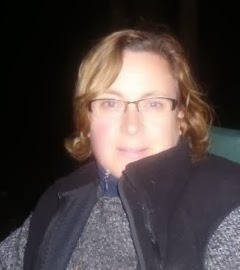
Teachers who inspired me shared their personal passions. Canadian literature and musical theatre are two interests I developed because a teacher’s passion was infectious. I have tried to personalize my teaching, hoping it will spark an interest.
My students will tell you I am passionate about my dogs, and I love to read aloud books about dogs and pet ownership. Time and again I go back to my favourite picture books about choosing pets, responsible pet ownership, and pets whose stories simply must be shared! Each spring we read about, talk about, and write about pets. Even those whose families do not have pets can imagine their “dream pet.”
I start with choosing the perfect pet: What Pet to Get? by Emma Dodd and the classic No More Monsters for Me by Peggy Parish, help to frame “if only” discussions. For slightly older students, I Wanna Iguana by Karen Kaufman Orloff and I Want a Dog! by Helga Bansch provide inspiration for persuasive writing activities. But sometimes, pets choose us, as in Hi! Fly Guy! by Tedd Arnold.
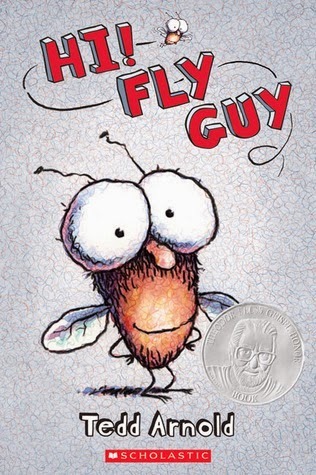
Once families have decided to get a pet (or two, or ...?) the hard work begins. Arthur’s Pet Business by Marc Brown inspires a brainstorming session about pets’ needs. There are also risks to pet ownership, including runaways, at which time John Grogan’s Bad Dog, Marley and Garrison Keillor’s Cat, You Better Come Home fit the bill. I lightly touch on the topic of spaying or neutering our pets and share the humourous story of Uncle Andy’s Cats by James Warhola (yes, the uncle is that Andy Warhol!).

Book reviews and some teaching materials are available from my local branch of the British Columbia Society for the Prevention of Cruelty to Animals (BCSPCA). There are so many reasons to adopt pets that have been “previously loved”, which leads to a discussion of compassion and caring, two aspects of character everyone can develop. Some of my favourite picture books about pet adoption have been reviewed by the BCSPCA: The Blue House Dog by Deborah Blumenthal, Two Bobbies by Mary Nethery and Kirby Larson, Before You Were Mine by Maribeth Boelts, A Home for Dakota by Jan Zita Grover and The Big Little Book of Happy Sadness by Colin Thompson. While each of these titles is tinged with sadness, the cathartic element leaves readers and listeners satisfied that each pet has found the right home.
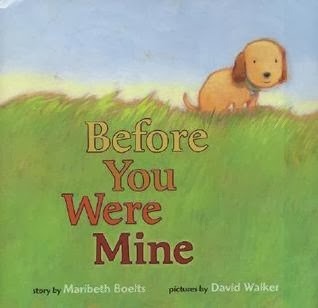
Finally, I make time to laugh about the animals that share our homes and our lives. Chowder by Peter Brown reminds students of the dogs they know that are treated by their owners like “fur children.”
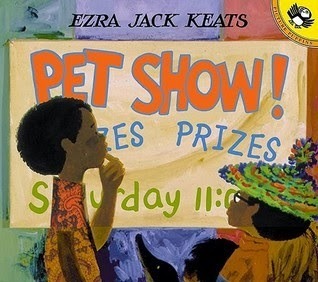
Pet Show! by Ezra Jack Keats inspires sympathy about the unwillingness of cats to be managed. Katie Loves the Kittens by John Himmelman and Dog in Charge by K.L. Going concern the problems that can arise when dogs and cats share a home.
 Lucinda's dog, Frodo
Lucinda's dog, FrodoThank you Lucinda for sharing so many great titles to connect us to the furry friends in our life, and for modeling how a teacher's passion for something can be an inspiration to students.
Published on February 06, 2014 05:30
February 5, 2014
Wednesday Wisdom
Oh, never mind the fashion. When one has a style of one's own, it is always twenty times better.
Mary Oliphant
Mary Oliphant
Published on February 05, 2014 05:30
February 4, 2014
From the Office of the Future of Reading
Please join me in welcoming today's guest blogger Sandra Bornstein. Sandra is a licensed Colorado teacher who has worked in the US and abroad. While living in India, she fulfilled three passions – a desire to travel, a zeal for writing, and a love of teaching. Sandra’s Indian adventure became the backdrop for her book, May This Be the Best Year of Your Life: A Memoir. She hosts a blog that focuses on education, family, and travel. Sandra also promotes authors via interviews and book reviews on her website. You can hear more from Sandra on Twitter or on Facebook.

In 2010, I stepped out of my comfort zone and accepted a teaching position at an international private boarding school in Bangalore, India. With considerable apprehension, I left behind my position teaching Intro to Education classes at a Colorado community college to teach fifth grade in a Third World country. My world was turned upside down as I coped with culture shock, loneliness, and learning a new British/Indian curriculum.
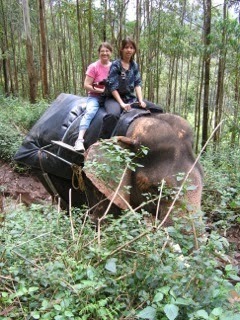
In India, I was able to apply my American training and experience to meet the needs of my students. I also infused different aspects of my American background into the established primary program. Since I was unable to travel with many books or materials, I relied on a terribly slow Internet connection for supplementary American resources.
Since my experience was limited to just one international school, I cannot say unequivocally that all private schools in India follow the same protocols. I did learn that most Indian teachers received similar or inferior training to my Indian colleagues. Even though a high percentage of Indian children are simultaneously learning two or more languages, few teachers were aware of any second language learning theories or methods. English was taught without any attempt to differentiate instruction. Upon realizing this, I immediately understood why so many of my students struggled with basic reading and writing skills.
The situation was further exacerbated by an emphasis on teaching writing via a series of grammar exercises. Very little time was spent actually writing. To create a more balanced approach, I provided writing prompts a few times a week. However, I quickly learned that if the students were not given a specific topic, they would become bewildered. A “free write” was too far outside their comfort zone. On a more formal level, I introduced my class, as well as the entire primary school to Ruth Culham’s 6 Traits Plus 1 writing program. Disappointingly, both my students and fellow teachers balked. I learned that change could be a slow process.
It was a challenge teaching one novel to a multicultural class of diverse learners. Once again, I used my American training to introduce educational tools such as graphic organizers and rubrics. It took many weeks for my students to learn the ins and outs of participating in literature circles. It was exciting to see the class master these unfamiliar skills.
But at the same time I questioned whether I was going too far.
“I toyed with the idea of taking the easy way out. If I simply followed the team, I would have minimal prep time and would grade grammar worksheets and simple one-line answers instead of meticulously grading actual writing. Taking such a shortcut would disrupt my forward motion and eliminate any hope of making significant improvements. I couldn’t forget that I was hired for my expertise and that the school was paying a premium for my education.” (May This Be the Best Year of Your Life: A Memoir pages 158-9)
My international experience allowed me to reset my compass. I adapted to a foreign culture and simultaneously shared my American background. I encourage individuals reading this guest blog to reexamine their life to determine if now is the right time to step outside of their comfort zone.
Thank you Sandra for sharing your experience and inspiring us to take that step out of our comfort zones. Though I've never moved to another country, my visits to Qatar, Lebanon, Germany and, most recently, Guam, have opened my eyes -- and heart! -- to our bigger world. I look forward to reading your memoir.
Published on February 04, 2014 05:30
February 1, 2014
Read this!
This year's Scott O'Dell winner for historical fiction is the charming and fresh Bo at Ballard Creek. Bo's mother, Mean Millie, wants to send her to an orphanage. But the nuns look so cross that miners Jack and Arvid take the little girl instead, raising her in the cold rough wonderful world of a small Alaska mining village. Her friends are of all ages -- from little Evaline to old Ollie -- and from everywhere. Some are good at morse code, some at making akutaq, some at baking cakes. At Ballard Creek, everyone is valued and respected. The village is small but Bo's world is large.

I will confess to putting the book down for a day: it was a bit too sweet and too good-to-be-true in spots and I do wish there had been a way for the author to stay completely in Bo's point of view. But after that day, I picked the book up again because I missed Bo and her papas too much. And the illustrations by LeUyen Pham are utterly exuberant!
This book reminds me of some of my own favorites: Susan and Arabella, Pioneers (Rhoda Morris), Our Only May Amelia (Jennifer Holm), The Penderwicks (Jeanne Birdsall), with a dash of Anne of Green Gables (L.M.M. Montgomery) thrown in for good measure. It seems like the perfect choice for a mother-daughter book club, or for anyone who has ever wondered what it would be like to be chased by a grizzly.

I will confess to putting the book down for a day: it was a bit too sweet and too good-to-be-true in spots and I do wish there had been a way for the author to stay completely in Bo's point of view. But after that day, I picked the book up again because I missed Bo and her papas too much. And the illustrations by LeUyen Pham are utterly exuberant!
This book reminds me of some of my own favorites: Susan and Arabella, Pioneers (Rhoda Morris), Our Only May Amelia (Jennifer Holm), The Penderwicks (Jeanne Birdsall), with a dash of Anne of Green Gables (L.M.M. Montgomery) thrown in for good measure. It seems like the perfect choice for a mother-daughter book club, or for anyone who has ever wondered what it would be like to be chased by a grizzly.
Published on February 01, 2014 05:30
January 31, 2014
Friend Friday
It is a delight to introduce you to my long-time friend, Lorie Ann Grover. Not only is glam on the outside, she is beautiful on the inside, too. Her compassion for teen readers led her to become one of the co-founders of ReaderGirlz and ReaderTotz. She writes cozy board/picture books and thought-provoking YA. You are going to want to read her newest book, due out on February 11!
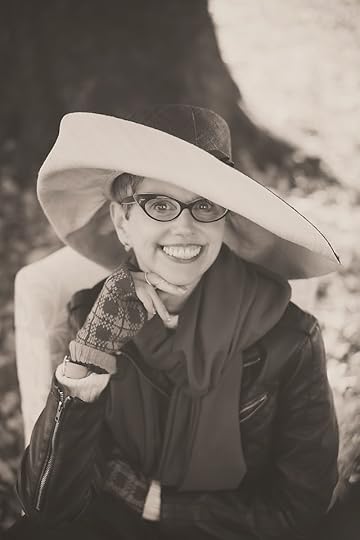 Lorie Ann Grover
Lorie Ann Grover
Kirby was so kind to ask me to share for a moment about my new release, Firstborn. I actually began the work in 2004. The ten year journey was a long trek with the original text written in verse, like my first three novels. After a few drafts it became apparent the concise verse format was not going to be able to carry the setting of my fantasy. There was not enough room for the description I needed to create a world, from landscape to culture. The verse white space was constricting my story.
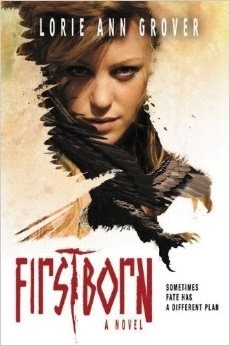
With that fact accepted, I needed to learn to write prose. A paragraph. Certainly a paragraph is simple to write, I thought. Ha! And so time passed as I read, wrote revisions, and read more. My patient agent, Elizabeth Harding at Curtis Brown, Ltd., would say, “Show us more of the movie you see in your head, Lorie Ann.” I’d reply, “Really? You still can’t see it? It’s so clear to me.” But I’d start another revision, describing and explaining more, writing paragraphs.
I’ve gathered that some authors write an immense number of words and then hone the work down, like a sculptor working over a piece of marble. Each strike makes the stone smaller and the art emerges. Other authors build word upon word, hardly ever cutting away story. They work like a sculptor building upon an armature, layering tiny piece upon piece. Whether writing in verse or prose, my process is the latter. Each revision is another layer as the entity takes shape, gains clarity, and grows solid.
Emma Dryden, my first editor who now also acts as a social media maven, waited and instructed me as I wrote my early verse novels. Loose Threads began as a picture book. She said, “I think this is a novel, Lorie Ann. Can you write more?” Thirty-two poems were my armature beneath that work. In Firstborn there is an entire verse novel beneath the prose, the bones on which the story stands.
After years of study, thankfully, for my new editor Jacque Alberta, I can write straight into prose without the verse bridge. I see the entire movie in my head and then write what I see. Ultimately, we must know the craft to tell the story. I'm so thankful for Kirkus' starred review of Firstborn. I learned to write paragraphs!
Special Note: Firstborn originally sprang from an article I read on gendercide. Over 37 million girls are missing today due to China’s One Child Policy. Visit Global Gendercide Advocacy Alliance Project or All Girls Allowed to learn more and act.
 Lorie Ann Grover
Lorie Ann Grover
Kirby was so kind to ask me to share for a moment about my new release, Firstborn. I actually began the work in 2004. The ten year journey was a long trek with the original text written in verse, like my first three novels. After a few drafts it became apparent the concise verse format was not going to be able to carry the setting of my fantasy. There was not enough room for the description I needed to create a world, from landscape to culture. The verse white space was constricting my story.

With that fact accepted, I needed to learn to write prose. A paragraph. Certainly a paragraph is simple to write, I thought. Ha! And so time passed as I read, wrote revisions, and read more. My patient agent, Elizabeth Harding at Curtis Brown, Ltd., would say, “Show us more of the movie you see in your head, Lorie Ann.” I’d reply, “Really? You still can’t see it? It’s so clear to me.” But I’d start another revision, describing and explaining more, writing paragraphs.
I’ve gathered that some authors write an immense number of words and then hone the work down, like a sculptor working over a piece of marble. Each strike makes the stone smaller and the art emerges. Other authors build word upon word, hardly ever cutting away story. They work like a sculptor building upon an armature, layering tiny piece upon piece. Whether writing in verse or prose, my process is the latter. Each revision is another layer as the entity takes shape, gains clarity, and grows solid.
Emma Dryden, my first editor who now also acts as a social media maven, waited and instructed me as I wrote my early verse novels. Loose Threads began as a picture book. She said, “I think this is a novel, Lorie Ann. Can you write more?” Thirty-two poems were my armature beneath that work. In Firstborn there is an entire verse novel beneath the prose, the bones on which the story stands.
After years of study, thankfully, for my new editor Jacque Alberta, I can write straight into prose without the verse bridge. I see the entire movie in my head and then write what I see. Ultimately, we must know the craft to tell the story. I'm so thankful for Kirkus' starred review of Firstborn. I learned to write paragraphs!
Special Note: Firstborn originally sprang from an article I read on gendercide. Over 37 million girls are missing today due to China’s One Child Policy. Visit Global Gendercide Advocacy Alliance Project or All Girls Allowed to learn more and act.
Published on January 31, 2014 05:30
January 30, 2014
From the Office of the Future of Reading
Please join me in welcoming today's guest blogger, Sue Johnson. Sue is an 8th grade Language Arts teacher at Washington Middle School in Olympia, Washington. Here is what Sue has to say about herself:
I am a teacher.
I wonder what tomorrow will bring.
I see hope in my student’s faces.
I want my own adult kids to be happy.
I pretend I can sing.
I worry about getting it all taught.
I cry when Charlotte dies and Wilbur carries on.
I understand learning can be hard work.
I say “I Love You!”
I dream of sandy beaches at the OBX.
I try to do my best.
I hope I make a difference.
I am a teacher.
Go Seattle Seahawks!!!
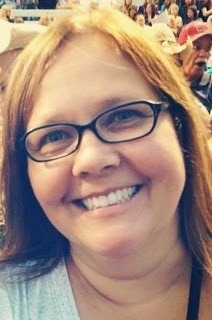
Middle School Readers, Keeping the Passion Alive!
“A book is a dream that you hold in your hands” – Neil Gaiman. Hundreds of books fill my classroom library after twenty years of teaching and, admittedly, a bit of a book buying addiction. Students and colleagues laugh at my burgeoning book baskets, but I just smile as kids from other rooms tip-toe in and ask if I have a title currently not available in the school library. Borrowing is always allowed. There is no fancy check-out program, just the honor system. Eventually the majority of books come back, sometimes several years later when a younger sibling has my class. But that’s why the books are there, to be borrowed, to be read. The more accessible the books the better! The class Mature Bookshelf requires a parent permission slip and contains books that may have topics like drug use, sex, under-age drinking, etc. Many 8th graders are ready for those tougher topics and I want to provide books that expose them to a bigger world, yet respect family choices. It’s difficult keeping the cart full.
We read every day at the beginning of class for about twenty minutes. Our class is fifty-eight minutes. It is worth every minute. Students need to read more in order to improve as readers. They are reading from books, magazines, off e-readers and their phones. I read when they read. Sometimes I’m reading a “teacher strategy” book, sometimes a student recommended book, and sometimes my own free choice. Students know I value reading, even if I’m not wearing my Read More Books t-shirt.
“Wow! We choose our own books to read?” or “Ms. J, have you read this book? You really should. It’s kind of like _______.” or “Get this book Ms. J. I bet other kids would read it.” You can bet with those comments the titles go on my to-be-purchased list. After their reading, students respond in journals showing how they connect to the plot, character, and setting. They “notice and note” what’s happening in their books, look deeper and read closer. This transformation occurred last year after attending workshops, reading books and following tweets by Donalyn Miller (Book Whisperer, Reading in the Wild), Penny Kittle (Book Love), Kylene Beers and Robert Probst (Notice and Note), and Smokey Daniels (Texts and Lessons for Content-Area Reading). My first step was the Read 40 Books Challenge explained in Donalyn Miller’s Book Whisperer. Last year about half of my 90 students met the challenge. Currently, at the halfway point in the year, 12 of my 145 students have already read 40 books!
Booktalks and Book Trailers spread the word on new, popular and/or “must-read” books. The internet provides an extensive choice of Book Trailers, but even better are student-made Book Trailers. Kids sell books to the other kids. The books from student-led Booktalks or Book Trailers disappear off the shelf. Sharing what we are reading with others increases interest and amount of reading by everyone.
There is no magic answer to the question, “Middle school readers, how do you keep the passion alive?” Our mission is to keep encouraging, continue modeling and remain open-minded in the ways we expose and share reading with kids. “If you only read the books that everyone else is reading, you can only think what everyone is thinking. – Haruki Murakami
I can feel the energy from your classroom all the way through cyberspace, Sue! Talk about making books available to kids. You take the cake!
Published on January 30, 2014 05:30
January 29, 2014
Wednesday Wisdom
Far and away, the best prize that life offers is the chance to work hard at work worth doing.
Theodore Roosevelt
Theodore Roosevelt
Published on January 29, 2014 05:30
Hafa Adai!
A year or so ago, a very sweet woman named Lolita approached me at the IRA conference and asked if I would consider coming to Guam. Though I had promised my long suffering husband that I would cut back on travel, I knew it was not coincidence that Lolita had approached me on behalf of the IRA-Guam Council: it was fate.
Lolita didn't know it at the time, but my book, DUKE (released in September 2014) included scenes from Guam during WWII. In fact, the story had been inspired in part by the moving memoir, Always Faithful, written by Captain William Putney, veterinarian for the Marine's War Dog unit. [check back soon for my interview with Sims Sears, daughter of Marvin Corff, whose name I gave to Duke's handler in my novel. You don't want to miss that!] Long story short, I couldn't say no and so on January 8, 2014, I flew to Guam, via Tokyo, to spend 11 intense days on that beautiful island.
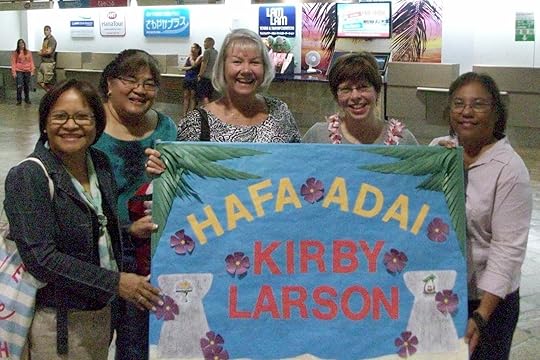
Here I am, bleary-eyed upon arrival. In fact, so bleary-eyed, I did not even notice this [hard-to-miss] welcome sign. I was whisked to my hotel for a quick night's sleep before my 9 am interview with local-boy-made-good, Ray Gibson, on Newstalk K-57. I can say quite honestly that Ray is the BEST interviewer I've ever encountered. That might be because he's a closet novelist himself.
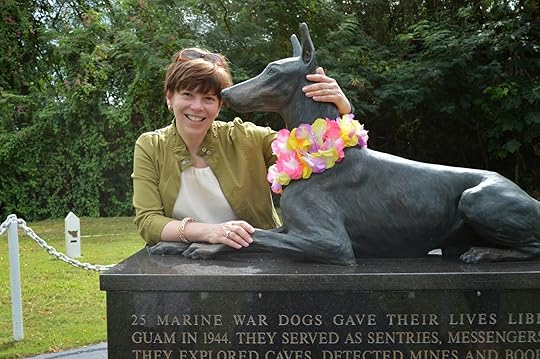
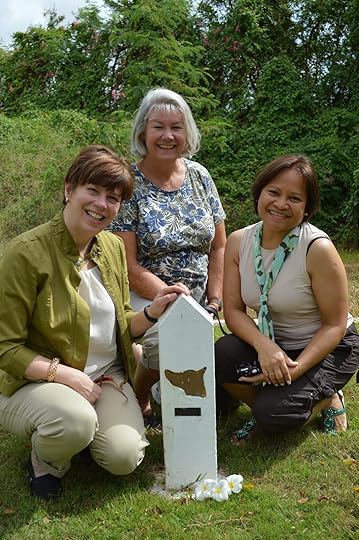 At the real Duke's memorial
At the real Duke's memorial
We left the radio station and headed straight for the Navy Base, where we were met by the well-prepared Shaina Santos, Public Affairs Specialist who escorted us onto the base and to my own personal Mecca: the War Dog Memorial. Though I had read about it and seen photos, I wasn't prepared for the emotional impact being there in person had on me. My companions -- Debbie Duenas, IRA-Guam President and Cyndy Pruski, Author Visit coordinator -- didn't bat an eye at my tears but they did orchestrate many a photograph, including one of my presenting a copy of DUKE for Capt. Mike Ward, commander of the base.
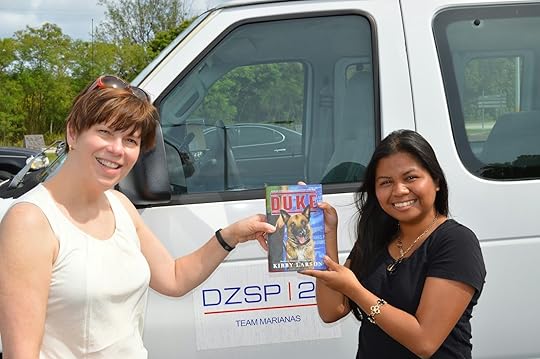
After our tour, we visited the T. Stell Newman Visitor Center which houses the War in Pacific museum, then drove up Nimitz Hill for a tour of Asan beach, which housed the original War Dog cemetery.
 Hard to believe this peaceful place was the site of terrible battles in WWII
Hard to believe this peaceful place was the site of terrible battles in WWII
After the tour, we enjoyed a tasty lunch until I fell asleep in my Pad Thai and my hosts returned me to my hotel. I only hope my snores did not keep the other guests awake that night.
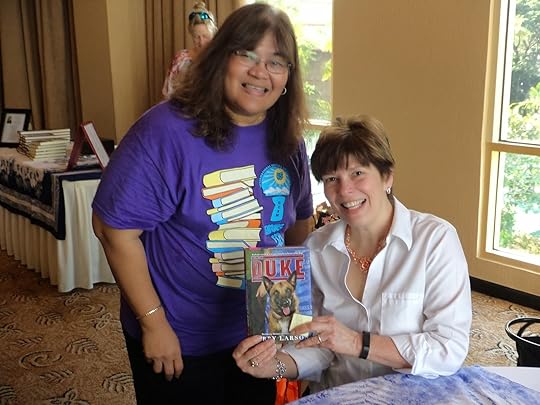 With Rosario Quinata
With Rosario Quinata

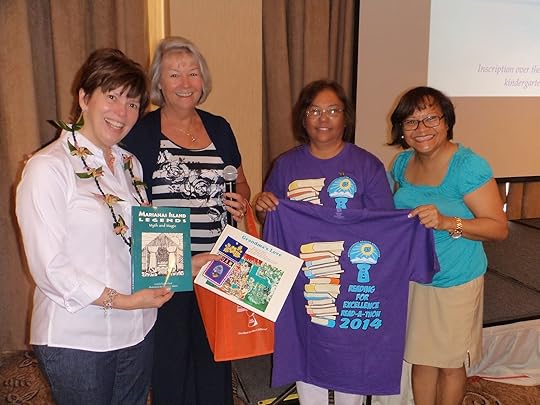 The stunning lei I'm wearing was made by Cyndi Pruski, to my right; Mary Livingston and Debbie Duenas
The stunning lei I'm wearing was made by Cyndi Pruski, to my right; Mary Livingston and Debbie Duenas
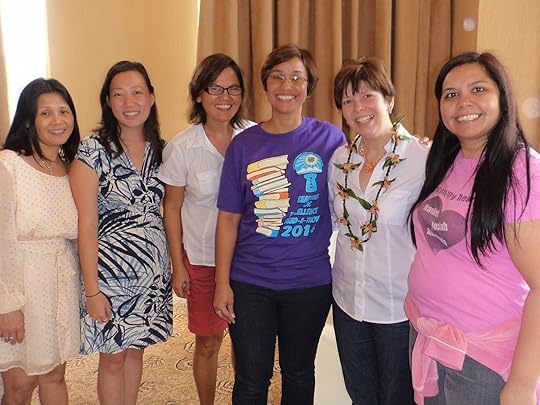 Lolita is on the far left
Lolita is on the far left
Saturday morning was spent chatting with the dedicated members of the Guam council of the IRA. I had such a lovely time! And they were very gracious about the fact that my Keynote slides were all messed up.
Another lunch [note: if you are invited to Guam, go on a diet beforehand!] and then back to my hotel.

I think I napped for a bit and then I hopped on one of the red "shopping" trolleys -- not to shop, but to get to Underwater World.

After a pleasant visit there, I decided to walk back to Gov. Flores park; even with a stop for gelato, I was tuckered out.
 Stunning flame tree at Gov. Flores park
Stunning flame tree at Gov. Flores park
And I clocked in 5 miles on my fitbit! I finally made it to the park, dipped my toes in the water, enjoyed the families having fun and caught the trolley back to my hotel where I fell into a coma.
Sunday morning: breakfast at the island icon: Shirley's. I had an egg white omelette with island grown eggplant and absolutely delicious coffee. After working on some copyedits, it was time to don my swimsuit and my courage for a boat trip with Vickie McLoughran and her darling New Yorker husband, Rich. Vickie was certain she would be able to get this water baby snorkeling; it happened but only momentarily and while I was hanging on for dear life to the boat's ladder.

No matter. It was a marvelous outing during which I got to meet a young man named Kind and see the western most point of the United States: Udall Point.
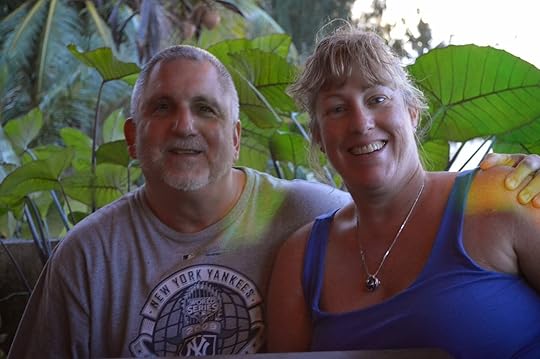 Vickie and Rich
Vickie and Rich
Vickie, Rich and I shared pizza and stories at sunset to the soundtrack of a young GI singing country western songs at a beachside restaurant. The perfect ending to the day!
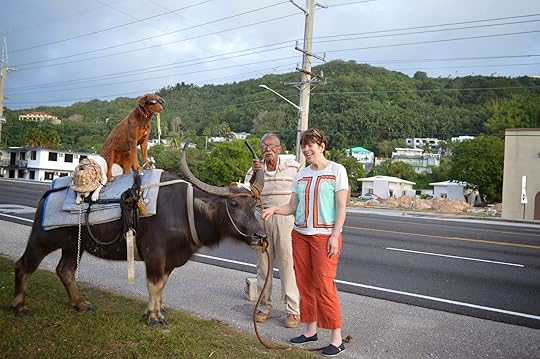 Some friends we met along the way. The beast of burden is a caraboa
Some friends we met along the way. The beast of burden is a caraboa
Monday morning, I was driven by the darling Anita (who insisted on buying me a latte) to Carbullido Elementary and thus began the whirlwind of school visits: 15 schools in 5 days.
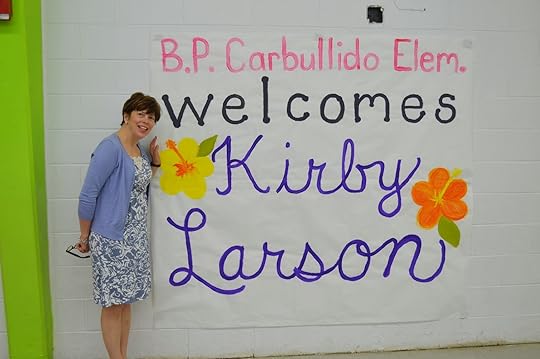


I wish I could share every moment with you. Let's just say that the kids were ADORABLE and the teachers so supportive and welcoming.

I was incredibly spoiled by the presents, leis, attention, and fiesta food. Tears are welling up in my eyes as I write this, remembering the kindness bestowed upon me.
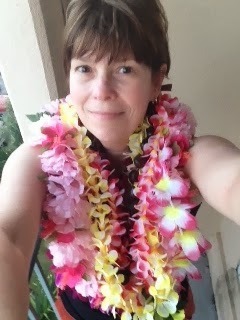 A selfie with some of the leis I was given
A selfie with some of the leis I was given
Some additional highlights: a taping at PBS Guam where I only muffed my lines 99 times; a teacher workshop after school on Tuesday; a visit to the Chamorro Village; a looong walk on the beach on Thursday; dinner with new friends at the Outrigger, music provided by Jesse and Ruby.
 View from Fort Soledad
View from Fort Soledad
Aside from the school visits, 2 favorite memories include a Friday afternoon drive with Rosario Quinata who showed me the village where she grew up and showed me the stunning southern part of the island; and the world's quickest tour of Dos Amantes (Two Lovers Point). Special thanks to Donovan for humoring the three old ladies he got stuck with on Saturday afternoon!
 view from Two Lover's Point
view from Two Lover's Point
In several weeks, lots of us will be gathering at the IRA conference in New Orleans. I'll be there and so will a hardy contingent from Guam, armed with letters of invitation for attending authors/illustrators. If you are lucky enough to receive one of said invitations, say yes.
 Guam: Where America's day begins
Guam: Where America's day begins
Lolita didn't know it at the time, but my book, DUKE (released in September 2014) included scenes from Guam during WWII. In fact, the story had been inspired in part by the moving memoir, Always Faithful, written by Captain William Putney, veterinarian for the Marine's War Dog unit. [check back soon for my interview with Sims Sears, daughter of Marvin Corff, whose name I gave to Duke's handler in my novel. You don't want to miss that!] Long story short, I couldn't say no and so on January 8, 2014, I flew to Guam, via Tokyo, to spend 11 intense days on that beautiful island.

Here I am, bleary-eyed upon arrival. In fact, so bleary-eyed, I did not even notice this [hard-to-miss] welcome sign. I was whisked to my hotel for a quick night's sleep before my 9 am interview with local-boy-made-good, Ray Gibson, on Newstalk K-57. I can say quite honestly that Ray is the BEST interviewer I've ever encountered. That might be because he's a closet novelist himself.

 At the real Duke's memorial
At the real Duke's memorialWe left the radio station and headed straight for the Navy Base, where we were met by the well-prepared Shaina Santos, Public Affairs Specialist who escorted us onto the base and to my own personal Mecca: the War Dog Memorial. Though I had read about it and seen photos, I wasn't prepared for the emotional impact being there in person had on me. My companions -- Debbie Duenas, IRA-Guam President and Cyndy Pruski, Author Visit coordinator -- didn't bat an eye at my tears but they did orchestrate many a photograph, including one of my presenting a copy of DUKE for Capt. Mike Ward, commander of the base.

After our tour, we visited the T. Stell Newman Visitor Center which houses the War in Pacific museum, then drove up Nimitz Hill for a tour of Asan beach, which housed the original War Dog cemetery.
 Hard to believe this peaceful place was the site of terrible battles in WWII
Hard to believe this peaceful place was the site of terrible battles in WWIIAfter the tour, we enjoyed a tasty lunch until I fell asleep in my Pad Thai and my hosts returned me to my hotel. I only hope my snores did not keep the other guests awake that night.
 With Rosario Quinata
With Rosario Quinata
 The stunning lei I'm wearing was made by Cyndi Pruski, to my right; Mary Livingston and Debbie Duenas
The stunning lei I'm wearing was made by Cyndi Pruski, to my right; Mary Livingston and Debbie Duenas
 Lolita is on the far left
Lolita is on the far leftSaturday morning was spent chatting with the dedicated members of the Guam council of the IRA. I had such a lovely time! And they were very gracious about the fact that my Keynote slides were all messed up.
Another lunch [note: if you are invited to Guam, go on a diet beforehand!] and then back to my hotel.

I think I napped for a bit and then I hopped on one of the red "shopping" trolleys -- not to shop, but to get to Underwater World.

After a pleasant visit there, I decided to walk back to Gov. Flores park; even with a stop for gelato, I was tuckered out.
 Stunning flame tree at Gov. Flores park
Stunning flame tree at Gov. Flores parkAnd I clocked in 5 miles on my fitbit! I finally made it to the park, dipped my toes in the water, enjoyed the families having fun and caught the trolley back to my hotel where I fell into a coma.
Sunday morning: breakfast at the island icon: Shirley's. I had an egg white omelette with island grown eggplant and absolutely delicious coffee. After working on some copyedits, it was time to don my swimsuit and my courage for a boat trip with Vickie McLoughran and her darling New Yorker husband, Rich. Vickie was certain she would be able to get this water baby snorkeling; it happened but only momentarily and while I was hanging on for dear life to the boat's ladder.

No matter. It was a marvelous outing during which I got to meet a young man named Kind and see the western most point of the United States: Udall Point.
 Vickie and Rich
Vickie and RichVickie, Rich and I shared pizza and stories at sunset to the soundtrack of a young GI singing country western songs at a beachside restaurant. The perfect ending to the day!
 Some friends we met along the way. The beast of burden is a caraboa
Some friends we met along the way. The beast of burden is a caraboaMonday morning, I was driven by the darling Anita (who insisted on buying me a latte) to Carbullido Elementary and thus began the whirlwind of school visits: 15 schools in 5 days.



I wish I could share every moment with you. Let's just say that the kids were ADORABLE and the teachers so supportive and welcoming.

I was incredibly spoiled by the presents, leis, attention, and fiesta food. Tears are welling up in my eyes as I write this, remembering the kindness bestowed upon me.
 A selfie with some of the leis I was given
A selfie with some of the leis I was givenSome additional highlights: a taping at PBS Guam where I only muffed my lines 99 times; a teacher workshop after school on Tuesday; a visit to the Chamorro Village; a looong walk on the beach on Thursday; dinner with new friends at the Outrigger, music provided by Jesse and Ruby.
 View from Fort Soledad
View from Fort SoledadAside from the school visits, 2 favorite memories include a Friday afternoon drive with Rosario Quinata who showed me the village where she grew up and showed me the stunning southern part of the island; and the world's quickest tour of Dos Amantes (Two Lovers Point). Special thanks to Donovan for humoring the three old ladies he got stuck with on Saturday afternoon!
 view from Two Lover's Point
view from Two Lover's PointIn several weeks, lots of us will be gathering at the IRA conference in New Orleans. I'll be there and so will a hardy contingent from Guam, armed with letters of invitation for attending authors/illustrators. If you are lucky enough to receive one of said invitations, say yes.
 Guam: Where America's day begins
Guam: Where America's day begins
Published on January 29, 2014 05:30
January 28, 2014
From the Office of the Future of Reading
Please join me in welcoming today's guest blogger, John Scovill. John is a staff developer in St. George, Utah. He has taught 1st, 3rd, 5th, and 7th grades. He loves books and sharing ideas on how to engage readers and connect readers to books. John also loves to write and hopes to be an author someday. He is married to a teacher and has two small children.

I taught fifth grade two years ago. My goal before school started was to connect my students with authors and to bring authors into my classroom though Skype. I wanted to make my classroom more open and connected.
Through Twitter, I was introduced to the book Bigger Than a Breadbox by Laurel Snyder. I loved the student-made trailer. I had my students view the trailer and told them that this book was going to be our next read aloud. They were excited because the trailer hooked them, a book about children, divorce, and magic!
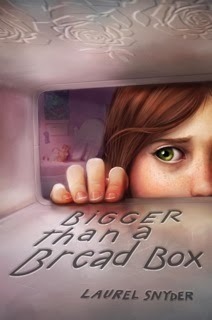
The next day two students came up to me and said, “Mr. Scovill, my mom and dad and I went to the bookstore and we bought the book!” The excitement I had was contagious, I guess.
That night, I tweeted Laurel Snyder and told her that two of my students bought her book. A kid buying a hardcover book is a huge investment! She later tweeted me back saying that she wanted to write to these two students. I tweeted her my school address and a week later a letter came in the mail. I gave the letters to the students. It totally made their day. After they read the letter, they placed the letter neatly on their desks next to the stack of books they were reading.
Later that day, the two came up to me and said that they wanted to write back to the author. I said that that would be a great idea. They got paper and started to write. After they were done, they handed them to me to mail.
After school, I opened one of the letters and read it. My student wrote to the author saying that she really connected to the book and the main character because her parents were going through a divorce. I didn’t know this was happening.
This student felt open to tell Laurel what was happening in her family and how the book, Bigger Than a Breadbox, affected her and helped her. This connection, this heartfelt connection between a fifth grade girl and a book helped me to understand why I do what I do…to spread the words that Penny Kittle coined “BOOK LOVE”.
Thank you John for sharing this story. What a wonderful illustration of the powerful connections all readers can make with books.
Published on January 28, 2014 15:00



